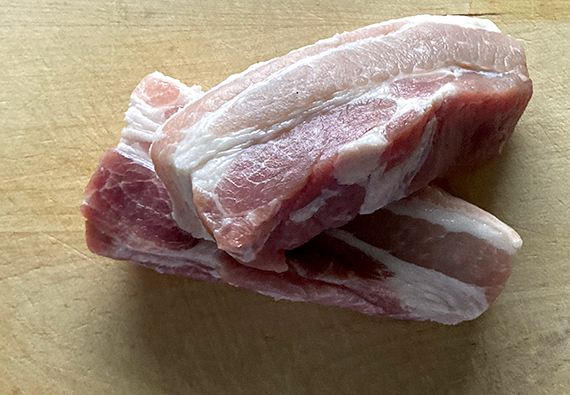Kimchi Jjigae (Kimchi Stew)
This traditional Korean stew of kimchi and pork belly is a savory, tangy, spicy dish perfect for cold weather.
Servings 4
Ingredients
- 1 tablespoon olive oil
- 1 small onion, halved and cut into thin slices
- 2 cloves garlic, chopped
- 8 ounces thick skinless pork belly, cut into bite-sized pieces (see Kitchen Notes)
- 1 teaspoon Korean red chili flakes—gochugaru (or to taste—see Kitchen Notes)
- 2 cups kimchi, coarsely chopped (see Kitchen Notes)
- 1-1/2 cups water
- 1-1/2 cups reduced-sodium chicken broth (or fish or beef stock, or more water)
- 1 tablespoon red chili paste—gochujang (or to taste—see Kitchen Notes)
- 1 tablespoon soy sauce
- 8 ounces firm tofu, cubed into bite-sized pieces
- salt, if needed
- scallions, thinly sliced for garnish
- cooked white rice, if desired
Instructions
- Heat oil in a Dutch oven or good-sized saucepan over medium flame. Add onion and garlic. Cook, stirring constantly for about 45 seconds. Add pork belly and red chili flakes, and stir to combine. Cook, stirring occasionally, for 5 to 7 minutes.
- Add kimchi, stirring everything to combine, and cook 3 to 5 minutes, stirring occasionally. Add water, broth, soy sauce and red chili paste, stirring to combine. Bring to a boil, reduce heat to a simmer, cover and cook for 5 to 7 minutes, stirring occasionally. Taste the broth and see if you want to dial up the heat a little, either with the chili flakes or paste (sorry, but you can’t dial it down at this point).
- Stir in the tofu, cover and cook for about 5 minutes. Taste and adjust seasonings with salt, if needed.
- Spoon into bowls, top with scallions and serve. You can serve it with white rice, if you like, or on its own. (You can also let it cool without the scallions, then refrigerate it and reheat it gently the next day for a delicious make-ahead meal.)
Kitchen Notes
About the pork belly. You want it skinless and ideally about an inch thick. Some recipes use more thinly sliced pork belly, and that’s fine if that’s what is available to you. Pork is the traditional meat for jjigae, but you can substitute any meat you choose, or even make it meatless.
 Gochugaru, gochujang and spiciness. Most recipes call for both. For our recipe, 1 teaspoon of the red chili flakes (look for coarse, but it won’t seem very coarse) and 1 tablespoon of the red chili paste delivered great flavor and a nice level of spiciness. Some recipes call for much more than that, with fiery results. Let your taste buds and heat tolerance be your guide. If you don’t want to use or buy both, opt for the paste; it delivers sweet, savory flavor along with the heat.
Kimchi. Most recipes call for kimchi that’s old and fully fermented for the most potent taste. Realistically, use what you can find. Also, if you need to chop it, make it very coarse, with generous-sized pieces.
Gochugaru, gochujang and spiciness. Most recipes call for both. For our recipe, 1 teaspoon of the red chili flakes (look for coarse, but it won’t seem very coarse) and 1 tablespoon of the red chili paste delivered great flavor and a nice level of spiciness. Some recipes call for much more than that, with fiery results. Let your taste buds and heat tolerance be your guide. If you don’t want to use or buy both, opt for the paste; it delivers sweet, savory flavor along with the heat.
Kimchi. Most recipes call for kimchi that’s old and fully fermented for the most potent taste. Realistically, use what you can find. Also, if you need to chop it, make it very coarse, with generous-sized pieces.
 Gochugaru, gochujang and spiciness. Most recipes call for both. For our recipe, 1 teaspoon of the red chili flakes (look for coarse, but it won’t seem very coarse) and 1 tablespoon of the red chili paste delivered great flavor and a nice level of spiciness. Some recipes call for much more than that, with fiery results. Let your taste buds and heat tolerance be your guide. If you don’t want to use or buy both, opt for the paste; it delivers sweet, savory flavor along with the heat.
Kimchi. Most recipes call for kimchi that’s old and fully fermented for the most potent taste. Realistically, use what you can find. Also, if you need to chop it, make it very coarse, with generous-sized pieces.
Gochugaru, gochujang and spiciness. Most recipes call for both. For our recipe, 1 teaspoon of the red chili flakes (look for coarse, but it won’t seem very coarse) and 1 tablespoon of the red chili paste delivered great flavor and a nice level of spiciness. Some recipes call for much more than that, with fiery results. Let your taste buds and heat tolerance be your guide. If you don’t want to use or buy both, opt for the paste; it delivers sweet, savory flavor along with the heat.
Kimchi. Most recipes call for kimchi that’s old and fully fermented for the most potent taste. Realistically, use what you can find. Also, if you need to chop it, make it very coarse, with generous-sized pieces.